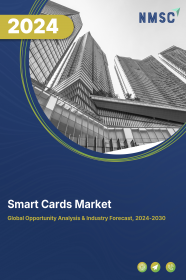
Smart Cards Market by Type (Memory and MPU Microprocessor), by Interface (Contact Cards, Contactless Cards, Hybrid Cards, and Dual Interface), by Component (Hardware, Software, and Service), by Functionality (Transaction, Communication, Access Control), and by Application (IT and Telecommunication, Healthcare, Banking, Financial Services and Insurance, Government, Transportation, Retail, Education, and Others) - Global Opportunity Analysis and Industry Forecast 2022-2030
Market Definition
The Smart Cards Market was valued at USD 13.42 billion in 2021 and is predicted to reach USD 20.51 billion by 2030, registering a CAGR of 5.1% from 2022 to 2030.
Smart cards, also known as chip cards are embedded physical cards with an integrated chip that acts as a token of service resource. It gets connected to a resource by direct physical contact standards such as radio-frequency identification (RFID) or near-field communication (NFC) as well as through short-range wireless connectivity. Smart cards are designed to be tamper-resistant and apply encryption in the construction of memory to ensure that consumer transactions are secure. These memory chips or smart card microprocessors exchange data with card readers and other systems over a serial interface. The data from the smart card reader is passed to its intended destination, generally an authentication system or a payment over a specific network connection.
Market Dynamics and Trends
The increasing adoption of smart cards in government IDs, as well as the widespread application of chip cards in retail services that provide encryption and security, are expected to drive the smart cards market during the forecast period. Also, the rising acceptance of digital payment methods to ensure better convenience and security over traditional cash-based payments is projected to fuel the growth of smart cards industry.
For instance, in July 2020, Giesecke and Devrient introduced contactless prepaid payment cards issued by the Macao government that are pre-loaded with credit. This introduction was intended to minimize the financial crisis caused by the COVID-19 pandemic, provide economic support to its consumers, and ensure security. Moreover, the rising security demands of information related to the user’s credentials along with the surging demand for smart gadgets such as smartwatches that incorporate smart chips for mobile payments are anticipated to drive the market growth in the forecasted period.
However, the increasing number of online and offline frauds as well as the presence of other financial payment techniques such as internet banking, cheques, and others are factors expected to restrain the growth of the market during the forecast period. On the contrary, the development of revolutionary technologies for enhanced security, including Blockchain that ensures secured & quick applications and transactions is expected to create lucrative opportunities for the smart cards market in near future.
Market Segmentation and Scope of Study
The global smart cards market is segmented on the basis of type, interface, component, application, and geography. Based on type, the market is classified into memory and MPU microprocessor. On the basis of interface, the market is categorized into contact cards, contactless cards, hybrid cards, and dual interface. Based on component, the market is divided into hardware, software, and service. On the basis of application, the market is segmented into IT and telecommunication, healthcare, banking, financial services and insurance, government, transportation, retail, education, and others. Geographical breakdown and analysis of each of the aforesaid classification include regions such as North America, Europe, Asia-Pacific, and RoW.
Geographical Analysis
Asia-Pacific dominated the global smart cards market in 2021 and is expected to remain dominant throughout the forecast period. This is attributed to factors such as government support for the development of infrastructural facilities that include banking, transportation, and others. Also, the increasing number of emerging business models in this region incorporating IoT that employ these chip cards is propelling the growth of the smart cards market in this region.
In addition, smart cards are gaining traction in the BFSI sector, owing to the difficulty in decoding the data stored on them. Advancements in security components in smart cards are opportunistic for the growth of the market. For instance, in January 2021, StashFin, a Singapore-based neo-banking start-up, teamed with SBM Bank India to develop a contactless prepaid card powered by VISA and equipped with an EMV chip that provides greater safety and security.
North America is expected to exhibit substantial growth in the global smart cards market during the forecast period, due to increasing government investments in the automation of ticketing and access control for the convenience of passengers and streamline control. Also, factors such as the booming rise of the e-commerce industry, along with the growing demand for e-passports as a result of globalization are expected to fuel the growth smart card market in this region.
Moreover, the presence of key vendors in this region such as CPI Card Group and Inteligensa, that are focusing on expanding their geographical presence and creating sustainable products are boosting the market growth. For instance, in June 2020, Visa and CPI Card Group introduced the Earthwise™ High Content Card, which is made with up to 98 percent upcycled plastic, dependent on design, for a more sustainably produced card. This product is an exclusive offering for Visa clients and cardholders.
Competitive Landscape
Some of the key market players operating in the global smart cards market include CPI Card Group, HID Global Corporation, Watchdata, Inteligensa, Eastcompeace, Thales, Giesecke and Devrient GmbH, IDEMIA, Infineon Technologies AG, and NXP Semiconductors NV. These market players are adopting various strategies such as product launches and joint ventures across various regions to maintain their dominance in the global smart cards market.
For instance, in March 2022, CPI Card Group unveiled its Push Provisioning service solution that was aimed at facilitating the tokenization of Mastercard debit and credit cards. This is done through in-app provisioning to a wide network of mobile wallets that includes Google Pay, Apple Pay, Samsung Pay, and others. In addition, in April 2021, Giesecke and Devrient GmbH joined hands with Vodafone and Bundesdruckerei in order to introduce a new electronic ID function for smartphones. This new electronic ID service integrated in the eSIM into a smartphone was developed to protect and secure the storage of the user’s identification data.
KEY BENEFITS
-
The smart cards market report provides a quantitative analysis of the current market and estimations from 2022 to 2030. This analysis assists in identifying the prevailing market opportunities to capitalize on.
-
The study comprises a comprehensive analysis of the smart cards market trends including the current and future trends for depicting the prevalent investment pockets in the market.
-
The competitive analysis of the market players along with their market share in the smart cards market is mentioned.
-
The SWOT analysis and Porter’s Five Forces model are elaborated in the study.
-
The value chain analysis in the market study provides a clear picture of the stakeholders’ roles.
Key Market Segments
By Type
-
Memory
-
MPU Microprocessor
By Interface
-
Contact Cards
-
Contactless Cards
-
Hybrid Cards
-
Dual Interface
By Component
-
Hardware
-
Software
-
Service
By Application
-
IT and Telecommunication
-
Healthcare
-
Banking, Financial Services and Insurance (BFSI)
-
Government
-
Transportation
-
Retail
-
Education
-
Others
By Geography
-
North America
-
U.S.
-
Canada
-
Mexico
-
-
Europe
-
U.K.
-
Germany
-
France
-
Italy
-
Spain
-
Rest of Europe
-
-
Asia-Pacific
-
China
-
India
-
Japan
-
South Korea
-
Australia
-
Rest of Asia-Pacific
-
-
RoW
-
UAE
-
Saudi Arabia
-
South Africa
-
Brazil
-
Remaining countries
-
Key Players
-
CPI Card Group
-
HID Global Corporation
-
Watchdata
-
Inteligensa
-
Eastcompeace
-
Thales
-
Giesecke and Devrient GmbH
-
IDEMIA
-
Infineon Technologies AG
-
NXP Semiconductors NV




















 Speak to Our Analyst
Speak to Our Analyst

























